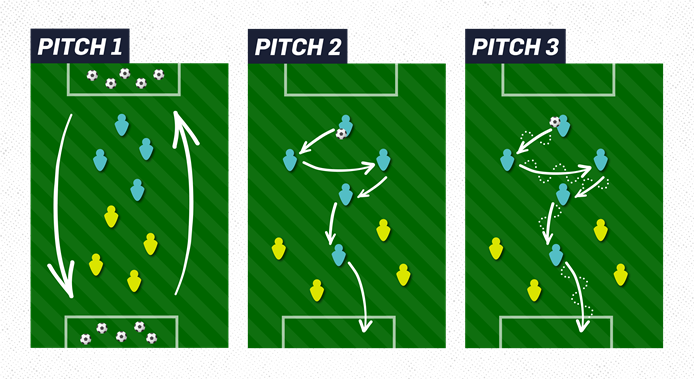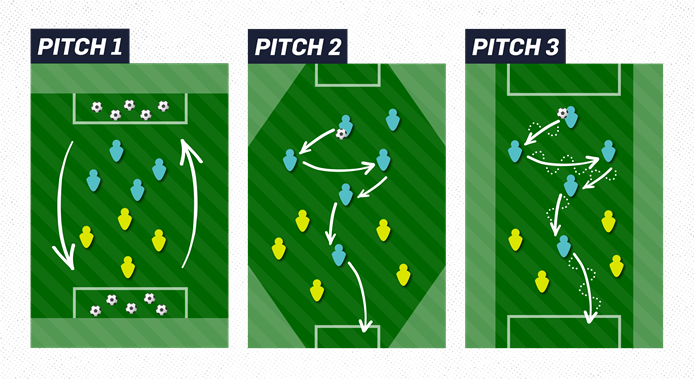In this blog, The FA’s coach development officer, Sharon Muxworthy discusses how she uses parallel games to benefit players and offers examples of how they can be adapted.
How do I, as a coach, keep all players enjoying my sessions and ensure they are developing and learning throughout the season, at an appropriate level? Yes, you guessed it. I am a wizard and with a twist of my wand, I can have all players focused, practicing and playing... if only?
Joking aside, there are a few ‘go to’ practice designs that help me create sessions that are fun and inclusive; giving players opportunities to socialise with their peers and refine their skills with the freedom a game-based approach can afford.
A key aspect of these practice designs is ensuring players find them fun. If they enjoy the opportunity to play, with their friends, they will be more motivated which can help to maximise their development.
Parallel games is a practice design that has enabled me to run such fully inclusive and enjoyable sessions.
Setting up games on parallel pitches, with slightly different constraints, can ensure all players will achieve some success. It can also help to stretch and challenge them to refine and acquire skills.
Coaches can adapt, modify and exaggerate the practice design, by applying the STEP principles, to help their players progress with their decision-making. One example of this is to use a practice design titled: three games, three ways.
Three Games, Three Ways
Setting up three pitches that run parallel to one another can allow you to influence the development of your players, in all four corners of the holistic development model, without losing the fun and enjoyment element of playing.
For example, the three pitches could have different pieces/amounts of equipment to encourage movement and help players recognise and deny space.

Pitch 1
Each team starts with several footballs in their goal and, as a team, they must race against their opponents to get the footballs out of their goal into their opponents and achieve an empty net. Each team must empty their goal of footballs. This game can start with the ball at feet or in hand or could be both, the choice of which could be given to the players. Be mindful of your reasons for the choice of the game. If you’re trying to include all players, it may be better to start with one attacking team and one defending team initially.
Pitch 2
Normal football rules apply but the number of passes that lead to a goal becomes the scoring amount: e.g. 5 passes ending with a shot into goal = 5 points.
Pitch 3
Rollerball/Hand Ball – Exploring different ways of working as a team to score without moving with the ball. Players can instead pass the ball by rolling or throwing it (depending on ability/age). This type of setup would be ideal for players who have been disengaged with physical activity and can help to develop their confidence and love of movement.
The benefits of setting up your practice in this way are:
- It is easy to set up, with minimal equipment, before the players arrive
- It can allow you to apply a whole-part-whole coaching approach
- The coach can have the rules of each game on a whiteboard or laminated card by each pitch for the players to interpret, apply and use to get started quickly.
- The coach can direct players to the pitch with the parallel game best suited to their needs.
- The ownership of running the games can be given to the players. They can self-referee helping them to understand how to deal with conflict and develop their own ways of self-regulation, ensuring the game is fairly run.
- It allows players to explore different ways to replicate and develop their movement patterns for attacking, defending and to exploit space and deny space.
Using the principle of STEP in parallel game design can help you as a coach to bring out all elements of the game. In the examples above I changed the tasks or the amount of equipment, but you could also change the space or people. There are some questions below for you to consider:
SPACE
- What reward will a wider pitch give you as a coach?
- What decision does a diamond pitch force the player to make more regularly, in different parts of the diamond?
- What does a longer narrower pitch encourage or challenge your players to do?
PEOPLE
- Do you need the sides to be equal where could an overload of players help you develop the realism of the game?
- Do the number of players increase as part of a reward or do you increase the challenge for the side who last scored?

Parallel game design can be used to achieve many positive outcomes when delivering high-quality football sessions, as part of coaching a team or with an inclusion focus. The highlight for me is that every player, who experiences this design, will only be focused on the tasks they have been given to work on. Rather than feeling separated from the group because they are not of the same ability.
What do you think of Sharon’s ideas here? How do you keep all players enjoying your sessions, whether it is in a school setting, football team or adult recreation setting? Let us know in the comments below!



-

Vinny Halsall
-
Cancel
-
Vote Up
0
Vote Down
-
-
Sign in to reply
-
More
-
Cancel
Comment-

Vinny Halsall
-
Cancel
-
Vote Up
0
Vote Down
-
-
Sign in to reply
-
More
-
Cancel
Children